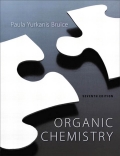
Organic Chemistry
7th Edition
ISBN: 9780321918765
Author: Bruice
Publisher: PEARSON EDUCATION (COLLEGE)
expand_more
expand_more
format_list_bulleted
Concept explainers
Question
Chapter 23.11, Problem 22P
Interpretation Introduction
Interpretation: The reason for why mannose is not formed in the enzyme catalyzed reaction and mannose is one of the products when glucose undergoes base-catalyzed isomerization in the absence of a catalyst has to be explained
Concept introduction:
- Enzyme is a protein that is a biological catalyst. The reactant in a reaction catalyzed by the enzyme is called substrate. In the enzyme, a pocket like cleft is present called active site where it binds the substrate.
- Some amino acid chains in the enzyme act as base, acid and nucleophilic catalyst. Many of the enzymes contain metal ions at the active site which acts as catalyst.
- Acid Catalyst helps in increasing the rate of a particular reaction by the donation of a proton to substrate.
- Base Catalyst helps in increasing the rate of a particular reaction by the removal of a proton to substrate.
- Nucleophilic catalysis helps in increasing the rate of a particular reaction by the formation of a covalent bond with substrate
- Glycolysis: A series of reactions where glucose is converted to two pyruvate molecules in the presence of enzymes catalysis.
Expert Solution & Answer
Trending nowThis is a popular solution!

Students have asked these similar questions
If you take crystals of the disaccharide lactose the natural substrate for beta-galactosidase and drop them in water, why doesn’t the lactose immediately react with the water and come apart into glucose and galactose?
When glucose undergoes base-catalyzed isomerization in the absence of the enzyme, mannose is one of the products that is formed. Why is mannose not formed in the enzyme-catalyzed reaction?
β-Galactosidase is an enzyme that hydrolyses only β(1,4) linkages of lactose. An unknown trisaccharide is converted by β-galactosidase into maltose and galactose. Draw the structure of the trisaccharide.
Chapter 23 Solutions
Organic Chemistry
Ch. 23.2 - Compare each of the mechanisms listed here with...Ch. 23.2 - Prob. 3PCh. 23.2 - Prob. 4PCh. 23.3 - a. Draw the mechanism for the following reaction...Ch. 23.5 - Prob. 7PCh. 23.5 - Propose a mechanism for the Co2+ catalyzed...Ch. 23.6 - Prob. 9PCh. 23.7 - Prob. 10PCh. 23.7 - Prob. 12PCh. 23.7 - Prob. 13P
Ch. 23.9 - Which of the following amino acid side chains can...Ch. 23.9 - Which of the following C-terminal peptide bonds is...Ch. 23.9 - Carboxypeptidase A has esterase activity as well...Ch. 23.9 - Arginine and lysine side chains fit into trypsins...Ch. 23.9 - Explain why serine proteases do not catalyze...Ch. 23.10 - If H2 18O is used in the hydrolysis reaction...Ch. 23.10 - When apples that have been cut are exposed to...Ch. 23.11 - Prob. 22PCh. 23.11 - The pHactivity profile for glucose-6-phosphate...Ch. 23.11 - Draw the pH-activity profile for an enzyme that...Ch. 23.12 - Prob. 25PCh. 23.12 - Draw the mechanism for the hydroxide ion-catalyzed...Ch. 23.12 - What advantage does the enzyme gain by forming an...Ch. 23.12 - Prob. 28PCh. 23.12 - Aldolase shows no activity if it is incubated with...Ch. 23 - Which of the following parameters would be...Ch. 23 - Prob. 30PCh. 23 - Prob. 31PCh. 23 - Prob. 32PCh. 23 - Indicate the type of catalysis that is occurring...Ch. 23 - The deuterium kinetic isotope effect (KH2O/KD2O)...Ch. 23 - Prob. 35PCh. 23 - Co2+ catalyzes the hydrolysis of the lactam shown...Ch. 23 - there are two kinds of aldolases. Class I...Ch. 23 - Prob. 38PCh. 23 - The hydrolysis of the ester shown here is...Ch. 23 - Prob. 40PCh. 23 - At pH = 12, the rate of hydrolysis of ester A is...Ch. 23 - 2-Acetoxycyclohexyl tosylate reacts with acetate...Ch. 23 - Proof that an imine was formed between aldolase...Ch. 23 - Prob. 44PCh. 23 - a. Explain why the alkyl halide shown here reacts...Ch. 23 - Triosephosphate isomerase (TIM) catalyzes the...
Knowledge Booster
Learn more about
Need a deep-dive on the concept behind this application? Look no further. Learn more about this topic, chemistry and related others by exploring similar questions and additional content below.Similar questions
- Yeast, Saccharomyces cerevisiae, fermented sucrose faster than glucose and fructose. Why? and why was it not able to ferment galactose?arrow_forwardif the disaccharide maltose is formed from two glucose monosaccharides which are hexose sugars how many atoms of carbon hydrogen and oygen does maltose contain and why?arrow_forwardPolysaccharides are synthesized by a. plants and animals b. removal of water (dehydration synthesis) c. connecting glucose molecules together d. formation of specific glycosidic bonds between monomers e. all of thesearrow_forward
arrow_back_ios
arrow_forward_ios
Recommended textbooks for you
 General, Organic, and Biological ChemistryChemistryISBN:9781285853918Author:H. Stephen StokerPublisher:Cengage Learning
General, Organic, and Biological ChemistryChemistryISBN:9781285853918Author:H. Stephen StokerPublisher:Cengage Learning Organic And Biological ChemistryChemistryISBN:9781305081079Author:STOKER, H. Stephen (howard Stephen)Publisher:Cengage Learning,
Organic And Biological ChemistryChemistryISBN:9781305081079Author:STOKER, H. Stephen (howard Stephen)Publisher:Cengage Learning, Introduction to General, Organic and BiochemistryChemistryISBN:9781285869759Author:Frederick A. Bettelheim, William H. Brown, Mary K. Campbell, Shawn O. Farrell, Omar TorresPublisher:Cengage Learning
Introduction to General, Organic and BiochemistryChemistryISBN:9781285869759Author:Frederick A. Bettelheim, William H. Brown, Mary K. Campbell, Shawn O. Farrell, Omar TorresPublisher:Cengage Learning- Chemistry: Matter and ChangeChemistryISBN:9780078746376Author:Dinah Zike, Laurel Dingrando, Nicholas Hainen, Cheryl WistromPublisher:Glencoe/McGraw-Hill School Pub Co
 Organic ChemistryChemistryISBN:9781305580350Author:William H. Brown, Brent L. Iverson, Eric Anslyn, Christopher S. FootePublisher:Cengage Learning
Organic ChemistryChemistryISBN:9781305580350Author:William H. Brown, Brent L. Iverson, Eric Anslyn, Christopher S. FootePublisher:Cengage Learning Introductory Chemistry: A FoundationChemistryISBN:9781337399425Author:Steven S. Zumdahl, Donald J. DeCostePublisher:Cengage Learning
Introductory Chemistry: A FoundationChemistryISBN:9781337399425Author:Steven S. Zumdahl, Donald J. DeCostePublisher:Cengage Learning

General, Organic, and Biological Chemistry
Chemistry
ISBN:9781285853918
Author:H. Stephen Stoker
Publisher:Cengage Learning

Organic And Biological Chemistry
Chemistry
ISBN:9781305081079
Author:STOKER, H. Stephen (howard Stephen)
Publisher:Cengage Learning,

Introduction to General, Organic and Biochemistry
Chemistry
ISBN:9781285869759
Author:Frederick A. Bettelheim, William H. Brown, Mary K. Campbell, Shawn O. Farrell, Omar Torres
Publisher:Cengage Learning

Chemistry: Matter and Change
Chemistry
ISBN:9780078746376
Author:Dinah Zike, Laurel Dingrando, Nicholas Hainen, Cheryl Wistrom
Publisher:Glencoe/McGraw-Hill School Pub Co

Organic Chemistry
Chemistry
ISBN:9781305580350
Author:William H. Brown, Brent L. Iverson, Eric Anslyn, Christopher S. Foote
Publisher:Cengage Learning

Introductory Chemistry: A Foundation
Chemistry
ISBN:9781337399425
Author:Steven S. Zumdahl, Donald J. DeCoste
Publisher:Cengage Learning